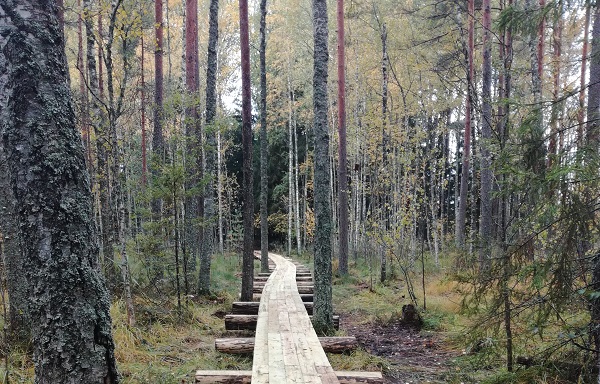Latvia’s State Forests Set up a Wooden Footbridge to the Partisans' Memorial Site in Stompaki Bog
JSC “Latvia’s State Forests” (LVM) has made the Latvian national partisan settlement and battle memorial site in Stompaki Bog, Viļaka Municipality, more accessible to visitors by constructing a wooden footbridge over the wet areas on the trail that takes to this historic site.
“The project was implemented in cooperation with the local government of Viļaka Municipality arranging the approximately kilometre long footbridges in four stages in order to cross the wet and swampy places,” says Dainis Rudzītis, Head of LVM Ziemeļlatgale Region Forest Management Planning.
Road signs to the Latvian national partisan settlement, which after World War 2 was set up on the islands of Stompaki Bog, are located on the road Balvi-Viļaka. When entering the forest, we are taken to a well-equipped parking lot with an informative stand from which the path to the partisan settlement starts.
“We started the footbridge construction works already last year, when we laid wooden benches along the path so that visitors could have a rest on their way to the historic memorial site. We started the construction of wooden footbridges in late summer this year to complete the project by the significant date for our country. Now visitors can reach the memorial site in Stompaki Bog without making their feet wet, since the wetlands can now be crossed using the wooden footbridges that are 319 m long; before there were tiny pine trunks that were not safe or comfortable,” says Dainis Rudzītis, Head of LVM Ziemeļlatgale Region Forest Management Planning.
“As the centenary of Latvia is approaching, the local government plans to set up more information stands at the memorial site and along the footbridge that next to the historical data will also contain information about natural and environmental values, since Stompaki Boge is a nature reserve included in the Natura 2000 network of specially protected areas of European significance”, says Dainis Rudzīts.
Historians believe that the partisan settlement in Stompaki Bog was one of the largest in the Baltics. It had 24 underground bunkers and a number of surface structures for around 400 people. In one of the dugouts, there was even a church. On 2 March 1945, the famous Battle of Stompaki took place here, when KGB army troops attacked the dugouts. The battles lasted all day long, the partisans fought hard and the attackers suffered heavy losses. The next night, the partisans broke the siege of the camp and left unbeaten. There are currently only a few trenches and a white cross in the place where there once was the church that tell about the events that took place at that time.



